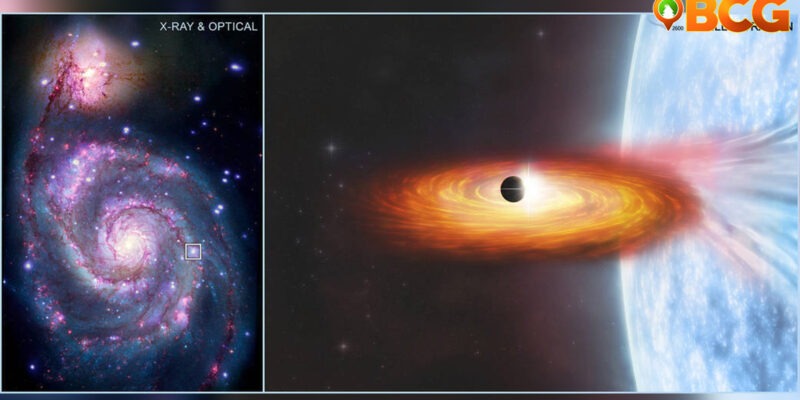Astronomers May Have Found the First Planet Outside Our Galaxy
Astronomers may have found the first evidence of a planet located outside the Milky Way Galaxy. In a study led by Rosanne Di Stefano of the Center for Astrophysics at Harvard & Smithsonian (CfA) in Cambridge, Massachusetts on Monday, signs of a planet transiting a star outside our galaxy have been detected for the first time.
Until now, exoplanets, which are planets found outside our solar system, have only ever been found within the Milky Way Galaxy, just 3,000 light-years away from Earth.
The extragalactic planet was found in the Messier 51 (M51) galaxy, also known as the “Whirlpool” galaxy, which is about 28 million light-years away from Earth. Researchers used NASA’s Chandra X-ray Observatory to look for X-ray dips from binary systems, where a Sun-like star is in orbit around a neutron star or a black hole.

An artist’s rendering of the first planet candidate identified outside of our Milky Way galaxy is pictured next the M51 galaxy. A composite image of M51 with X-rays from Chandra and optical light from NASA’s Hubble Space Telescope contains a box that marks the location of the possible planet candidate. Credits: X-ray: NASA/CXC/SAO/R. DiStefano, et al.; Optical: NASA/ESA/STScI/Grendler
“We are trying to open up a whole new arena for finding other worlds by searching for planet candidates at X-ray wavelengths, a strategy that makes it possible to discover them in other galaxies,” said Rosanne Di Stefano
Researchers searched for dips in the brightness of X-rays emitted by these binary systems. The temporary dimming of X-rays may be a planet passing in front of a neutron star. Since the region producing bright X-rays is small, planet transits are easier to spot because they could block most or all of the X-rays. Using both Chandra and the European Space Agency’s XMM-Newton, researchers’ search covered three galaxies: 55 systems in M51, 64 systems in Messier 101, and 119 systems in Messier 104, in which they have found one exoplanet candidate.
The exoplanet candidate was found in a binary system called the M51-ULS-1, which contains a black hole or neutron star orbiting a companion star with a mass 20 times larger than the Sun. Based on the X-ray transit that lasted about three hours, researchers have estimated the exoplanet candidate to be roughly the size of Saturn.
While this is a bold claim and tantalizing observation, verification is needed to confirm whether what they saw was indeed an extragalactic exoplanet. However, since the planet’s candidate orbit is large, it may not cross in front of its binary partner for about 70 years.
According to co-author Nia Imara of the University of California at Santa Cruz, “to confirm that we’re seeing a planet we would likely have to wait decades to see another transit.” She also added that because of the uncertainties about how long it takes to orbit, they wouldn’t know exactly when to look.
SOURCE: NASA Exoplanet Exploration















